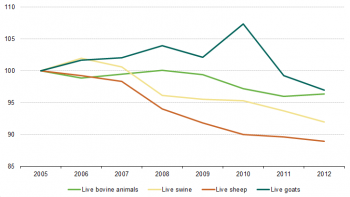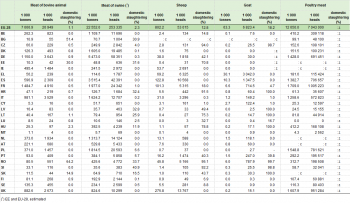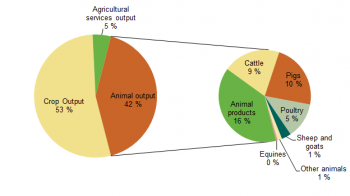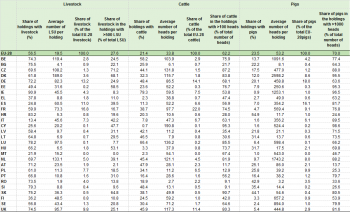Archive:Meat production statistics
- Data from November 2014. Most recent data: Further Eurostat information, Main tables and Database. Planned article update: (dd) Month YYYY(, hh:00).
This publication intends to give an overview of European meat production , according to the data provided to Eurostat by the Member States EU-28 in compliance with Regulation (EU) No1165/2008 concerning livestock and meat statistics. Data on livestock population categories are gathered from all EU Member States through a livestock survey conducted at least once a year (see Methodological Notes).

Source: Eurostat (apro_mt_lscatl), (apro_mt_lspig), (apro_mt_lssheep) and (apro_mt_lsgoat)

Source: Eurostat (ef_olslsuft) and (ef_olslsureg)
Main statistical findings
Since the decoupling of subsidies in 2003 (mid-term review) and under the latest Common Agricultural Policy (CAP), there the total number of livestock has decreased for the various species. Figure 1 is based on the total number of animals by livestock species, relatively to year 2005.
Between 2005 and 2013, the sheep livestock showed the most pronounced fall of ( 11.6%) for EU-14SHEEP followed by the total number of pigs(-8.6%) for the EU-28. The number of bovine animals fell (-3%) as wall as the number of goats (-2%) for EU-5GOAT.
There has been a drop in the total livestock as a whole. This trend has been kept until 2013 for pigs and sheep. However the herds of bovine animals (+1.5%) and of goats (0.9%) stopped decreasing in 2013, which might indicate a slight recovery for cattle meat.
According to the Farm Structure Survey, in 2010 nearly 7 million holdings (6.92 million) reared livestock, which represents 56.5% of the EU-28 farms. Still in proportion of all farms 23.5% had pigs, 21.4% bovine animals (cattle, buffaloes, etc.) 18.7% broilers, 7.7% sheep and 4.4% had goats.
Greening of agricultural systems was one of the pursued objectives during the latest CAP reform. Although raising livestock is justifiable ecologically, it does not necessarily mean that all ways of rearing are good or that ruminants are needed everywhere. Livestock farmers are therefore forced to adapt their farming systems if they hope to preserve their income and offer products geared to the market need and to societal demand for environmental friendly farming practices.
From 2009 to 2013 it can be observed (Figure 2) that the major increasing trend is in poultry meat which has seen an increase (7.03%). Pigmeat also increased (2.65%) while bovine meat has decreased by 6.2% and sheep meat and goat meat by 6.4%.
Economic relevance of animal production in the agricultural accounts is shown by the fact that 42% (172 billion €) of the total EU-28 agricultural output corresponds to this item. Animal production covers two items. Output for Animals is the value of animals produced either directly for slaughter, or used alive for herd renewal or for further growing and fattening. It represents 61% of the animal output. Animal products account for the 39% remaining and cover eggs, milk, wool, etc.
Slaughtering in the EU-28
Table 1 draws a general picture of European meat production though the statistics on slaughtering in 2013. Pigmeat appeared as the most important meat category: nearly 22 Mio tonnes were produced, i.e. 51% of annual production of all meats, followed by poultry meat with 12.7 Mio tonnes produced (30%). Bovine meat production represented 7.3 Mio tonnes (17%) and the meat from sheep and goat accounted for only 758 thousand, around 2% of all meats.
Other slaughtering in the EU-28
So-called other slaughtering is carried out other than in slaughterhouses. It is due to margin phenomenon everywhere, including. own-consumption, traditional or ritual slaughter. But it may be locally significant due also to incomplete implementation of hygiene legislation. The European Union has strong hygiene rules, and food is tracked at all stages of the production chain including slaughtering, processing and distribution, in order to guarantee food safety throughout Europe. (See data sources and availability)
In 2013 in EU 28, 77% of other slaughtering was recorded in the Member States having entered the EU in 2004 or later. In relative terms, other slaughtering accounted for 13% of total slaughtering in the 13 newest Member States and 0.5 % in the EU 15 . The general trend is a decrease, but other slaughtering remains at a significant level in Bulgaria and Romania. In Croatia, both kinds of slaughtering were not yet distinguished in 2013.
In Latvia, Croatia, Slovenia and Lithuania, other slaughtering have decreased, especially for bovine animals, but the numbers remain significant for pigs, sheep and goats. As a margin phenomenon, other slaughtering has fallen by 56% in EU-28 between 2009 and 2013. The contribution of the various species to other slaughtering is much higher for pigs (64.2%) than for small grazing livestock (19.0%) and bovine animals (16.8%). For this latter category the “adult cattle” (one year and older) account for 11.65% and "calves & young cattle" for 5.15%.
Bovine population an beef/veal meat
In terms of value, bovine animals represent 8.9% of the total agricultural output and 33% of the animal output, without taking into account the animal products (milk).
In EU-28 between 2007 and 2013, the number of suckler cows has decreased by 5%, from 12.5 to 11.9 million heads. This trend was especially marked on EU-15 (compared with the other EU 28 countries). Indeed the major part of the meat bovine herd is located in four Member States, namely France (34.5%), Spain (14.9%), the United Kingdom (13.0%) and Ireland (9.1%), and they represent together more than 70% of the European meat herd (Fig.3) This type of herd depends on changes in limited profitability of the sector and is thus sensitive to the level of subsidies from the Common Agricultural Policy.
Between 2009 and 2013, production of meat from heifers and bulls has fallen in EU-28 ( 10%) and EU-15 ( 13%). However, there has been an increase regarding veal, i.e. meat from calves (aged under 8 months) and young cattle (aged between 8 and 12 months), and its production has increased has been by around 27 % in the EU-28 and 30% for EU-15 during this period. Meanwhile the average carcass weight has increased by 2% for adult cattle (aged one year and over) and by 7% for calves and young cattle.
Finally, bovine production forecasts are expressed as Gross Indigenous Production (GIP), defined as the number of bovines animals slaughtered plus the net export (negative for net importers) of live bovine animals. This indicator is more likely to be produced based on the current livestock than slaughtering.
Compared to pigmeat production, beef meat production refers to a longer production cycle (see figure XXXX), feed efficiency is lower and value of individual animals is higher. Also diversity of animals produced for slaughter (feeding mode, age, dairy or meat breeds) makes the production systems more complex. All these factors together had led to tight margins and low profitability. The purchasing power of consumers is also a key determinant of the level of meat consumption. This is noticeable specially in the beef /veal sector where prices are significantly higher than for pig (or poultry) meat. Therefore these later ones are much more produced and consumed in Europe.
Pigmeat
As already highlighted, pigmeat is the major meat production in EU-28. The total number of pigs has decreased since 2004, but pigmeat production remained stable over the years or has even registered some peaks such as in 2007 and 2011. This reflects gains of efficiency in pig farming despite stronger regulatory constraints. This is more marked in EU-15 than in the other Members States (Figure XXXX). The total number of pigs has decreased from 2006 to 2013 by 10.3%. This trend can be explained mainly by lower profitability, due to economic and regulatory conditions, impacting the weakest farms. For instance Directive 2008/120/EC on the protection of pigs contributed in increasing the cost per sow in counterpart of their welfare. The larger pig farm size, as measured by their number of sows, appear as efficient in this context and they represent a higher share of the sector in EU-15 than in the other Member States. It reflects also disappearing of the smallest and less productive pig farming activities.
Meat from sheep and goats
Sheep and goat meat represents 1.4% of the total EU agricultural output. Based on the FSS in 2010, the 7.7% of farms have sheep and nearly half of the sheep belong to flocks over 500 heads. The share of goat farms is 4.4% and 51.5% of goats belong to flocks over 200 heads. These average figures smooth the contrasts between small herds, either in small rural farms or as side-production in larger ones, and larger herds, especially in regions with natural or environmental constraints. According to the legislation in force (see methodological notes), the 14 Members States with more than 500,000 sheep and the 5 Member States with more than 500,000 goats must provide statistics on the relevant livestock populations. Therefore all the figures presented refer to these countries. The 14 Member States reporting on sheep population can be displayed depending on the share of dairy ewes in the ewe flock (Table XX). The “Northern” countries have no or limited dairy production whereas dairy ewe mark sheep farming in the “Southern” countries.
The farming systems for sheep and goats in the Southern countries are comparable by complexity of their organisation to those for bovine animals in EU, with co-existing dairy and fattening flocks. Individual dairy animals are more profitable than meat animals and therefore they are more likely supported by technology than the meat animals (feeding, genetic progress, farm equipment, farmer education, etc.). Several types of meats are produced, either young animals from the dairy herd or heavier sheep from the meat herd, fattened on grassland or with feedstuff. Milk processing on farms is more frequent, as the daily milk volumes are lower than from cows’ milk, i.e. milk collection by a dairy is suitable only where dairy farm density on the territory is sufficient.
Between 2005 and 2013 the EU-28 sheep flock has been reduced by 10.96 million animals. During this latest year the trend continued to go down but the drop is smoother than in previous years, showing that maybe the sector is starting to be more stable. The EU drop reflects the important fall suffered in the main sheep meat producing countries (Figure XXXX). Spain lost 28% of its flock (6.4 million sheep), Portugal 29%), Ireland 24% and France 18%. The United Kingdom is by far the most important sheepmeat producer (20% of EU 28 production) lost by 4.7% of its flock. In contrast the sheep-flock grew in three countries, Romania (+20%) and Greece (+9%), where more than 90% of ewes are dairy ewes, and Sweden (+22%).
Farms with livestock
Farms with livestock decreased by 35 % since 2003
According to the results of the Farm Structure Survey (FSS) carried out in 2010, nearly 7 million holdings in the EU-28 reared animals, which represent 56.5 % of all EU-28 agricultural holdings (12.3 million). Among all holdings with livestock, 2.6 million holdings had cattle, 2.9 million kept pigs, 0.9 million had sheep, 0.5 million had goats and 2.3 million had broilers.
Since the last Farm Structure Survey carried out in 2003, the number of holdings with livestock reported a strong decrease of 35 %. Among the Member States with the highest share of holdings with livestock ranked Ireland (90.9 %), Croatia (83.2 %) and Slovenia (79.3 %), while the lowest share was reported in Italy with only 13.4 %. On the other hand, four Member States were responsible for more than 50 % of the EU-28’s total livestock (France 16.8 %, Germany 13.2 %, Spain 11 % and the United Kingdom 9.8 %).
In 2010, the average EU holding with livestock bred nearly 20 Livestock Units (LSU). This number varied considerably according to the type of animal and between the individual Member States. While in the most industrialised countries it was high (Denmark with 189 heads per farm, followed by the Netherlands with 133 heads and Belgium with 119 heads), the average farm in eight Member States didn’t exceed 10 animals. Among the latter, the lowest values were recorded in Romania (an average of 2 heads per farm), Bulgaria (4) and Croatia (5). The first group includes Member States with more specialised holdings on livestock breeding while the second group includes mainly countries which have large rural zones with many small farms.
As concerns cattle, and still according to the FSS results, there were slightly more than 2.6 million farms rearing nearly 89 million bovine animals in the EU-28 in 2010, corresponding to an average 34 animals per farm. This number again differs considerably depending on the country, with the highest average recorded in Cyprus (190.8), Luxembourg (136.2) and the Czech Republic (131.8) and the lowest in Romania (2.7), Bulgaria (6.1) and Lithuania (7.9). More than 62% of the EU-28 bovine animals are kept on farms having more than 100 heads of animals. Still, the highest share of holdings (36.4 %) had only between one and two bovine animals. Three Member States, France (22 %), Germany (14.1 %) and the United Kingdom (11.4 %) together accounted for nearly 50% of the total bovine animal population of the EU-28 in 2010.
Concerning the pig population, nearly 2.9 million EU-28 agricultural holdings reared slightly more than 153 million pigs in 2010, having thus on average 53.2 pigs per farm. Among the Member States with the highest average number of pigs per farm were Denmark (2 598), the Netherlands (1 743) and Ireland (1 253); Romania (3), Bulgaria (8) and Croatia HR (12) reported the lowest figures. Seventy percent of the EU-28’s pigs are kept on farms having more than 1000 animals, while more than 62 % of the EU-28 holdings had only one or two pigs. Four Member States together represented 53 % of the total pig population in the EU-28 in 2010: Germany (18 %), Spain (16.1 %), Poland (9.9 %) and France (9.1 %).
More than 900 thousand agricultural holdings across the EU-28 kept a total of nearly 96 million sheep (an average of 101.4 heads per holding). Seven Member States exceeded the average, most notably the United Kingdom with 443 sheep per farm, Spain (240) and Cyprus (192 ), while in other Member States the number of sheep did not reach more than 15 heads per farm (Malta, 11 and Lithuania, 15). Nearly half of the EU-28’s sheep are kept on farms having more than 500 animals, while more than 40% of the EU-28 holdings had between one and nine sheep. Almost half of the total EU-28 sheep population is found in only two Member States: the United Kingdom (32.3 %) and Spain (17.3 %).
Slightly more than 12 million goats were reared on around 500 thousand agricultural holdings in the EU-28 in 2010. The average number of goats per farm (22.8 animals) was exceeded by nine Member States, the highest values being reported by Cyprus (121), the Netherlands (95) and France (82). Little over half (51.5 %) of the EU-28’s goats are kept on farms having more than 200 animals, while more than 42 % of the EU-28 holdings had only one or two goats. More than one-third of the EU-28 total goat population (34.2 %) is found in Greece alone. Together with three other Member States (Spain, 19.2 %; France, 11.6 % and Romania, 10.1 %), they represented three-quarters of the total goat population in the EU-28 in 2010.
According to the FSS results, in 2010 nearly 884 million broilers were found on approximately 2.3 million farms in the EU-28, resulting in an average 386 broilers per farm. While three Member States reported more than 50 thousand heads per farm: Netherlands (69.6 thousand), the United Kingdom (59.9 thousand) and the Czech Republic (56.6 thousand), some Member States had farms with less than 200 broilers on average, the lowest numbers being reported by Romania with 22 heads per farm, followed by Croatia (156) and Portugal (192). More than one-third of the EU-28’s broiler population was bred on farms having more than 100 000 birds, while more than 98 % of all EU-28 holdings had less than 100 broilers.
Data sources and availability
- The Farm Structure Survey, a robust survey with a wide scope
From 2009 onwards, the structure of livestock rearing no longer forms part of an EU survey as such. Thus, the data are drawn from the FSS. Although this provides a wider scope (including land use, livestock, labour force, etc.) and a longer reference period, the results are less informative about the animal population than the data previously collected through the Livestock survey. Every third year, the Farm Structure Survey records data about the farm structure, which can be used for describing the structure of animal herds. The legal basis for the FSS is Regulation 1166/2008.
The Member States collect information on land use, livestock numbers, rural development, management and farm labour input from individual agricultural holdings. Based on the share of virtual value for standard output, activities of the farm (e.g. specialist cattle – rearing and fattening) are used to classify the type of farming. If the share of standard output from a particular activity items is more than two thirds of the total farm output, it is classified as ‘specialist acrtivity’.
- Livestock survey
The legal basis of the data collection on slaughtering and meat production is Regulation 1165/2008 of 19 November 2008 concerning livestock and meat statistics. The purpose of this Regulation is to establish a common legal framework for the systematic production of Community statistics on bovine, pig, sheep and goat livestock; slaughtering statistics on bovine animals, pigs, sheep, goats and poultry; and production forecasts of beef, veal, pigmeat, sheepmeat and goatmeat.
The livestock survey provides information about the livestock population at the national and regional level twice a year. The relevant data are intended to be more precise than the FSS figures. Furthermore, the nomenclature of livestock contains more animal categories. The surveys are conducted in all the EU countries at least once a year (in November/December). The Member States with at least 1.5 million bovine animals conduct a second survey in May/June. The regional data refer to the November/December survey. Moreover those Member States with less than 500.000 sheep do not have to survey the sheep population. The same exception concerns those Member States having less than 500.000 goats. Thus data on sheep populations have to be provided by only 13 Member States: BG, DE, IE, EL, ES, FR, HR, IT, HU, NL, PT, RO and UK which in 2009 (QR 2010) covered 97.2 % of the total EU-28 sheep population. Data on goat populations are due by only 5 Member States: EL, ES, FR, IT, and RO and those countries covered 83.0 % of the total EU-28 goat population in 2009 (QR 2010).
Data on slaughtering and meat production are collected on a monthly basis. In order to improve comparability of the results across Member States, two data sets are now collected, data on slaughtering in slaughterhouses and on slaughtering carried out other than in slaughterhouses. The latest are collected in order to estimate the total production.
- Economic Accounts for Agriculture (EAA)
The EAA is a satellite account of the European System of Accounts (ESA1995) providing complementary information and concepts adapted to the particular nature of the agricultural industry. Although their structure very closely matches that of the national accounts, their compilation requires formulating of appropriate rules and methods. Agricultural output measures the value of agricultural products (crop and animal products) produced during the accounting period. It includes the value of agricultural services and excludes the intra-unit consumption.
See also
Context
This article draws a portrait of the meat production in the EU in 2012, with a particular focus on slaughtering. It also deals with the structure of the European farms and the livestock population.
A 'Statistics in focus' publication will result from this article.
Further Eurostat information
Data visualisation
- Symbols & country abbreviations
‘:’ not available
‘c’ confidential data
‘:z’ not applicable
Main tables
- Agricultural production (t_apro)
- Livestock and meat(t_apro_cp)
- production of meat: pigs (tag00042)
- Production of meat: cattle (tag00044)
- Production of meat: sheep and goats (tag00045)
- Production of meat: poultry (tag00043)
- Livestock and meat(t_apro_cp)
Database
- Agriculture, see:
- Farm structure 2010 (ef_2010)
- Overview - Farm livestock (ef_ols)
Dedicated section
Methodology / Metadata
- Crops products: areas and productions (ESMS metadata file - ef_esms)


